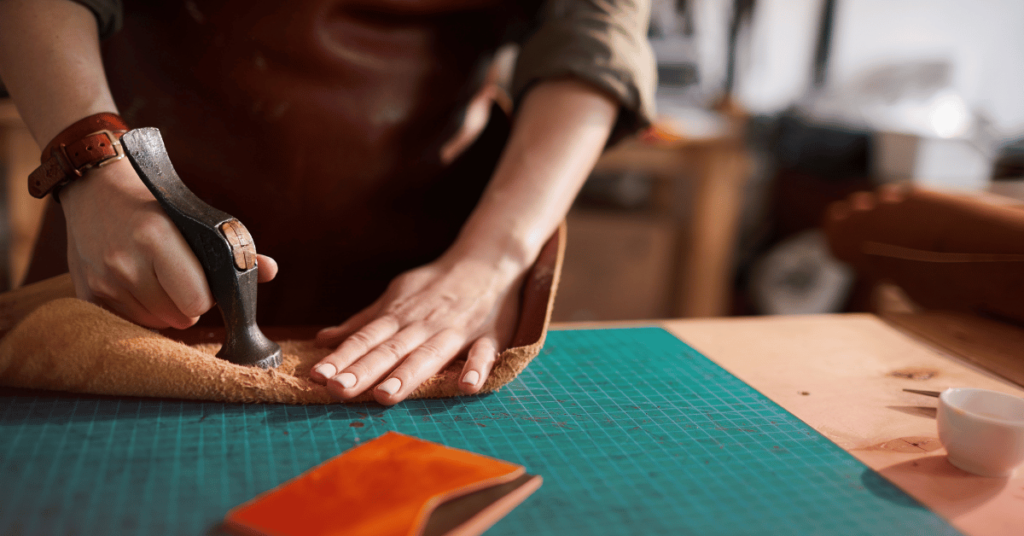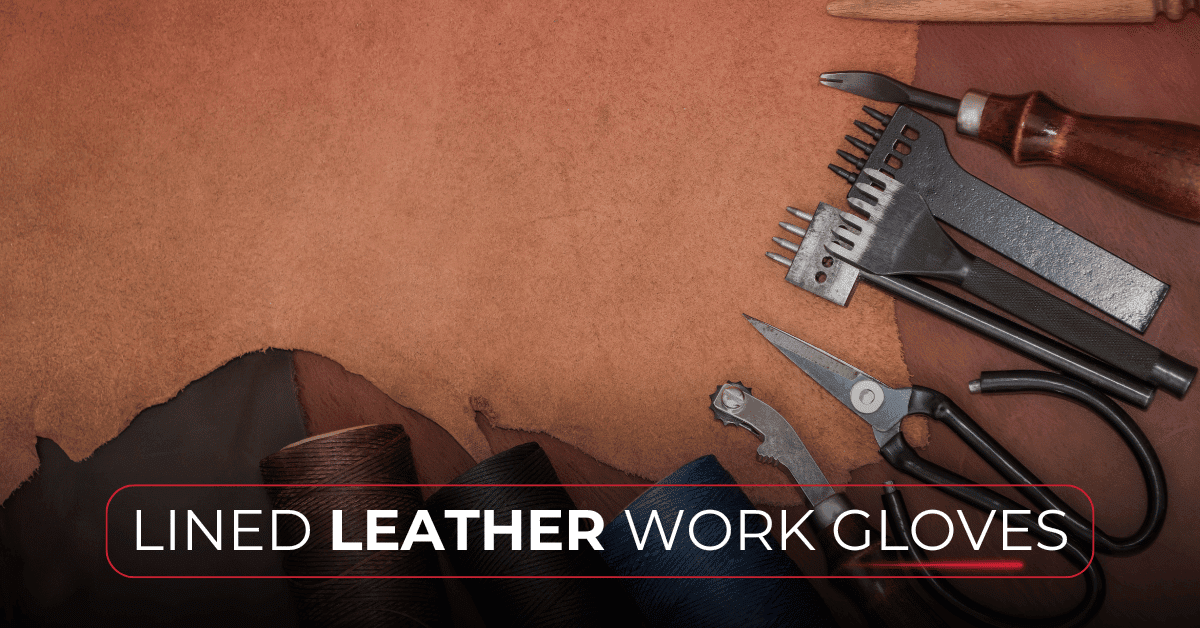Imagine a bustling construction site. Workers wield hammers, torches, and heavy machinery. Their hands are constantly exposed to a plethora of dangers – cuts, scrapes, burns, and abrasions. These injuries can not only cause immense pain and discomfort but also lead to lost workdays and hefty medical bills.
So, how can you safeguard your workers’ hands and ensure a safe and productive work environment? The answer lies in a simple yet powerful tool – lined leather work gloves.
Table of Contents
ToggleThe Problem: Exposed Hands on the Job
Construction sites, factories, and workshops are environments fraught with hazards for the hands. Workers face the constant threat of:
Cuts and scrapes:
From sharp tools and rugged materials, cuts and scrapes are a common occurrence in many workplaces.
Punctures:
Nails, screws, and other sharp objects can easily puncture the skin, leading to painful injuries and potential infections.
Burns:
Welding torches, hot machinery, and even exposure to sunlight can cause burns of varying degrees.
Abrasions:
Friction from repetitive tasks or contact with rough surfaces can cause abrasions, leading to discomfort and skin irritation.
These injuries are not only painful but can also significantly impact worker productivity and safety.
The Solution: Lined Leather Work Gloves
Lined leather work gloves are a vital piece of personal protective equipment (PPE) that offers a robust shield for your workers’ hands. These gloves typically consist of a durable outer layer of leather, often cowhide, deerskin, or goatskin, combined with a comfortable and protective inner lining.

Benefits of Lined Leather Work Gloves:
Enhanced Protection:
The tough leather exterior acts as a barrier against cuts, scrapes, punctures, and abrasions. The lining further enhances protection by adding an extra layer of defense.
Improved Durability:
Leather is a naturally strong and resilient material. Lined leather work gloves can withstand the wear and tear of demanding work environments, offering long-lasting protection.
Increased Comfort:
The inner lining provides additional cushioning and comfort, especially for extended wear. This translates to a happier and more productive workforce.
Versatility Across Industries:
Lined leather work gloves are not limited to construction. They offer valuable protection in various industries, including metalworking, gardening, landscaping, and even chemical handling (depending on the lining material).
Understanding the Different Types of Leather:
The type of leather used in lined leather work gloves plays a crucial role in their performance. Here’s a breakdown of the most common options:
Cowhide:
The most popular choice, cowhide offers a balance of affordability, durability, and protection. It’s ideal for general-purpose tasks.
Deerskin:
Softer and lighter than cowhide, deerskin offers superior dexterity and flexibility. It’s a good choice for tasks requiring fine motor skills, such as assembling small parts or operating machinery controls. However, deerskin may not be as durable as cowhide for heavy-duty applications.
Goatskin:
Known for its exceptional puncture resistance, goatskin is a valuable option for workers handling sharp objects or tools. It also offers good flexibility and dexterity, making it a versatile choice.
Exploring Lining Materials:
The lining material in lined leather work gloves significantly impacts comfort, warmth, and protection. Here are some common lining options:
Fleece:
This soft and fluffy lining provides excellent warmth and comfort, making it ideal for cold work environments.
Kevlar:
Known for its cut resistance, Kevlar lining offers an extra layer of protection against cuts from sharp objects like knives, glass, or sheet metal.
Thinsulate:
This high-tech synthetic material provides excellent insulation, keeping hands warm in cold weather conditions.
Water-repellent Linings:
These linings offer protection from moisture and light rain, keeping hands dry in wet environments. Some options include cotton canvas or even waterproof materials like Gore-Tex (depending on the specific glove).
Choosing the Right Lined Leather Work Gloves
Selecting the right lined leather work gloves for your workers requires careful consideration of several factors:
Task and Hazards:
Identify the specific tasks your workers perform and the hazards they face. For instance, construction workers might need heavy-duty gloves with cut resistance, while gardeners might prefer lightweight gloves with good dexterity.
Thickness and Weight:
The thickness and weight of the gloves will depend on the level of protection required. Lightweight gloves offer better dexterity for tasks requiring precision, while heavy-duty gloves provide maximum protection for heavy-duty work.
Features:
Consider additional features that enhance protection for specific jobs. Look for features like heat resistance for welding or metalworking tasks, water repellency for wet environments, or cut resistance for handling sharp objects.
Fit:
Proper sizing is crucial for both safety and comfort. Ill-fitting gloves can slip or bunch, reducing protection and dexterity. Measure your workers’ hands carefully and consult the size chart provided by the manufacturer.
Additional Considerations:
Glove liners can be worn underneath lined leather work gloves for added warmth and comfort, especially in cold environments. They can also help absorb moisture and extend the lifespan of the leather gloves.
Caring for Your Lined Leather Work Gloves
Proper cleaning and storage practices extend the lifespan of your lined leather work gloves. Here are some essential tips:
Follow the manufacturer’s cleaning instructions:
Different leathers and linings may require specific cleaning methods. Avoid harsh chemicals or excessive scrubbing, which can damage the leather.
Store gloves in a cool, dry place:
Avoid direct sunlight or heat sources, as this can dry out the leather and make it crack. Breathable storage containers help prevent moisture buildup.
Regular inspections:
Regularly inspect your gloves for signs of wear and tear, such as rips, tears, or loose stitching. Replace damaged gloves promptly to ensure optimal protection for your workers.
The Benefits of Buying Lined Leather Work Gloves in Bulk
Purchasing lined leather work gloves in bulk offers several advantages for businesses:
Cost Savings:
Buying in bulk often leads to significant savings compared to buying individual pairs. This translates to lower overall PPE costs for your company.
Consistent Quality and Reliable Stock:
Reputable suppliers ensure consistent quality in the gloves you receive. They also maintain a reliable stock, so you can be confident you’ll always have the gloves your workers need.
Access to Expert Guidance:
Reliable suppliers often have a team of experts who can answer your questions and guide you in choosing the right type of lined leather work gloves for your specific needs.
Conclusion: Investing in Safety and Productivity
Investing in high-quality lined leather work gloves is not just an expense; it’s an investment in the safety and well-being of your workers. Proper hand protection reduces the risk of injuries, leading to a healthier workforce and fewer lost workdays. Additionally, comfortable gloves enhance worker productivity and satisfaction. By choosing the right lined leather work gloves and implementing proper care practices, you can create a safer and more productive work environment for your team.
FAQs: Lined Leather Work Gloves Explained (10 Unique Questions)
1. How often should I replace lined leather work gloves?
The frequency depends on the usage intensity and the conditions the gloves are exposed to. Regularly inspect your gloves for signs of wear and tear, such as rips, tears, loose stitching, or compromised lining. Replace any damaged gloves to ensure optimal protection for your workers.
2. Can lined leather work gloves be washed?
Some lined leather work gloves can be washed, but always follow the manufacturer’s cleaning instructions. Using harsh chemicals or excessive scrubbing can damage the leather or lining. Spot cleaning with a mild soap solution and air drying is often recommended.
3. Are there alternatives to lined leather work gloves?
Yes, there are other work glove materials suited for specific applications. Here are a few examples:
- Kevlar: Offers excellent cut resistance for handling sharp objects.
- Nitrile rubber: Provides protection against chemicals and oils.
- Cotton: Ideal for lightweight tasks and general handling.
- Synthetic materials: Breathable and lightweight options for various tasks.
4. What are some signs that lined leather work gloves need to be replaced?
- Visible signs of wear and tear, such as rips, tears, or loose stitching.
- Loss of flexibility or dexterity due to hardened leather.
- Worn-out lining that no longer provides adequate comfort or insulation.
- A compromised fit, where the gloves become loose or baggy.
5. How can I store lined leather work gloves that aren’t currently in use?
Store them in a cool, dry place away from direct sunlight or heat sources. Breathable containers like canvas bags or mesh storage bins help prevent moisture buildup and potential mildew growth.
6. Do all lined leather work gloves offer heat resistance?
No, not all lined leather work gloves are heat resistant. Look for gloves specifically treated with heat-resistant materials like Nomex or Kevlar for welding or metalworking tasks.
7. Are lined leather work gloves waterproof?
Some lined leather work gloves may have a water-repellent coating for light moisture protection. However, for truly waterproof gloves, consider options with waterproof linings like Gore-Tex or other waterproof membranes.
8. What are the benefits of using a glove liner with lined leather work gloves?
Glove liners offer several advantages:
- Increased warmth and comfort: Especially beneficial in cold environments.
- Moisture absorption: Helps wick away sweat and keep hands dry.
- Extended lifespan of leather gloves: Glove liners act as a protective barrier, reducing wear and tear on the leather exterior.
- Improved dexterity: Thin liners can enhance dexterity compared to bulky gloves alone.
9. How can I ensure my workers are wearing the right size of lined leather work gloves?
Provide a size chart from the manufacturer and have your workers measure their hands carefully. A snug fit is ideal for optimal protection and dexterity. Err on the side of a slightly smaller size, as leather gloves can loosen slightly with wear.
10. Where can I find more information about lined leather work gloves?
Many companies that sell lined leather work gloves and safety equipment have detailed information on their websites. You can also find resources from government agencies or safety organizations that discuss hand protection in workplaces. Look for reputable sources like the Occupational Safety and Health Administration (OSHA) in the United States or the Canadian Centre for Occupational Health and Safety (CCOHS).









